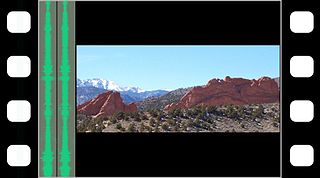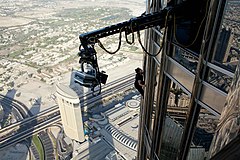
In filmmaking and video production, a crane shot is a shot taken by a camera on a moving crane or jib. Filmmaker D. W. Griffith created the first crane for his 1916 epic film Intolerance, with famed special effects pioneer Eiji Tsuburaya later constructing the first iron camera crane which is still adapted worldwide today. Most cranes accommodate both the camera and an operator, but some can be moved by remote control. Crane shots are often found in what are supposed to be emotional or suspenseful scenes. One example of this technique is the shots taken by remote cranes in the car-chase sequence of the 1985 film To Live and Die in L.A. Some filmmakers place the camera on a boom arm simply to make it easier to move around between ordinary set-ups.

Astrophotography, also known as astronomical imaging, is the photography or imaging of astronomical objects, celestial events, or areas of the night sky. The first photograph of an astronomical object was taken in 1840, but it was not until the late 19th century that advances in technology allowed for detailed stellar photography. Besides being able to record the details of extended objects such as the Moon, Sun, and planets, modern astrophotography has the ability to image objects outside of the visible spectrum of the human eye such as dim stars, nebulae, and galaxies. This is accomplished through long time exposure as both film and digital cameras can accumulate and sum photons over long periods of time or using specialized optical filters which limit the photons to a certain wavelength.

Steadicam is a brand of camera stabilizer mounts for motion picture cameras invented by Garrett Brown and introduced in 1975 by Cinema Products Corporation. It was designed to isolate the camera from the camera operator's movement, keeping the camera motion separate and controllable by a skilled operator.

A crane is a type of machine, generally equipped with a hoist rope, wire ropes or chains, and sheaves, that can be used both to lift and lower materials and to move them horizontally. It is mainly used for lifting heavy objects and transporting them to other places. The device uses one or more simple machines to create mechanical advantage and thus move loads beyond the normal capability of a human. Cranes are commonly employed in transportation for the loading and unloading of freight, in construction for the movement of materials, and in manufacturing for the assembling of heavy equipment.

Aerial photography is the taking of photographs from an aircraft or other airborne platforms. When taking motion pictures, it is also known as aerial videography.

A camera operator, or depending on the context cameraman or camerawoman, is a professional operator of a film camera or video camera as part of a film crew. The term "cameraman" does not imply that a male is performing the task.

In the United States, Canada and the United Kingdom, grips are camera support equipment technicians in the filmmaking and video production industries. They constitute their own department on a film set and are directed by a key grip. Grips have two main functions: The first is to work closely with the camera department to provide camera support, especially if the camera is mounted to a dolly, crane, or in an unusual position, such as the top of a ladder. Some grips may specialize in operating camera dollies or camera cranes. The second function is to work closely with the electrical department to create lighting set-ups necessary for a shot under the direction of the director of photography.
Grips' responsibility is to build and maintain all the equipment that supports cameras. This equipment, which includes tripods, dollies, tracks, jibs, cranes, and static rigs, is constructed of delicate yet heavy duty parts requiring a high level of experience to operate and move. Every scene in a feature film is shot using one or more cameras, each mounted on highly complex, extremely expensive, heavy duty equipment. Grips assemble this equipment according to meticulous specifications and push, pull, mount or hang it from a variety of settings. The equipment can be as basic as a tripod standing on a studio floor, to hazardous operations such as mounting a camera on a 100 ft crane, or hanging it from a helicopter swooping above a mountain range.
Good Grips perform a crucial role in ensuring that the artifice of film is maintained, and that camera moves are as seamless as possible. Grips are usually requested by the DoP or the camera operator. Although the work is physically demanding and the hours are long, the work can be very rewarding. Many Grips work on both commercials and features.

A professional video camera is a high-end device for creating electronic moving images. Originally developed for use in television studios or with outside broadcast trucks, they are now also used for music videos, direct-to-video movies, corporate and educational videos, wedding videos, among other uses. Since the 2000s, most professional video cameras are digital.

In cinematography, a jib is any boom device used to mount a camera on one end, and a counterweight with camera controls on the other. In principle, it operates like a see-saw, with the balance point located closer to the counterweight, which allows the end of the arm with the camera to move through an extended arc. Typically a jib permits the camera to be moved vertically, horizontally, or a combination of the two. A small jib can be mounted on a tripod, but many larger, purpose-built jibs have their own support stands, often on wheels. Modern jibs are normally modular and can be assembled in various lengths.

Panavision is an American motion picture equipment company founded in 1954 specializing in cameras and lenses, based in Woodland Hills, California. Formed by Robert Gottschalk as a small partnership to create anamorphic projection lenses during the widescreen boom in the 1950s, Panavision expanded its product lines to meet the demands of modern filmmakers. The company introduced its first products in 1954. Originally a provider of CinemaScope accessories, the company's line of anamorphic widescreen lenses soon became the industry leader. In 1972, Panavision helped revolutionize filmmaking with the lightweight Panaflex 35 mm movie camera. The company has introduced other cameras such as the Millennium XL (1999) and the digital video Genesis (2004).
Video assist is a system used in filmmaking that allows filmmakers to view and distribute a video version of a take immediately after it is filmed. On set, the location where the assist is reviewed is called a video village.

Philip H. Lathrop, A.S.C. was an American cinematographer noted for his skills with wide screen technology and detailed approach to lighting and camera placement. He spent most of his life in movie studios. Lathrop was known for such films as Touch of Evil (1958), Lonely Are the Brave (1962), The Americanization of Emily (1964), The Cincinnati Kid (1965), Point Blank (1967), Finian's Rainbow (1968), The Traveling Executioner (1970), Portnoy's Complaint (1972), Earthquake (1974), Swashbuckler (1976), The Driver (1978), Moment by Moment (1978), A Change of Seasons (1980), Foolin' Around (1980), Loving Couples (1980), and Deadly Friend (1986).
This article contains a list of cinematic techniques that are divided into categories and briefly described.

Anamorphic format is the cinematography technique of shooting a widescreen picture on standard 35 mm film or other visual recording media with a non-widescreen native aspect ratio. It also refers to the projection format in which a distorted image is "stretched" by an anamorphic projection lens to recreate the original aspect ratio on the viewing screen. The word anamorphic and its derivatives stem from the Greek anamorphoo, compound of morphé with the prefix aná. In the late 1990s and 2000s, anamorphic lost popularity in comparison to "flat" formats such as Super 35 with the advent of digital intermediates; however, in the years since digital cinema cameras and projectors have become commonplace, anamorphic has experienced a considerable resurgence of popularity, due in large part to the higher base ISO sensitivity of digital sensors, which facilitates shooting at smaller apertures.
Elevated photography is the process of taking aerial photos using a telescoping pole or mast, or other aerial or elevated support systems, to emulate aerial photographs, or video, taken from a commercially licensed aircraft.

A unit still photographer, or simply a still photographer creates film stills and still photographic images specifically for use in the marketing industry and for the publicity of feature films in the motion picture industry and network television productions. In addition to creating photographs for the promotion of a film, the still photographer contributes daily to the filming process by creating set stills. With these, the photographer is careful to record all details of the cast wardrobe, set appearance and background.

A television production truck or OB van is a small mobile production control room to allow filming of events and video production at locations outside a regular television studio. They are used for remote broadcasts, outside broadcasting (OB), and electronic field production (EFP). Some require a crew of as many as 30 people, with additional trucks for additional equipment as well as a satellite truck, which transmits video back to the studio by sending it up through a communications satellite using a satellite dish, which then transmits it back down to the studio. Alternatively, some production trucks include a satellite transmitter and satellite dish for this purpose in a single truck body to save space, time and cost.

John Arnold (1889–1964) was an American cinematographer. He began his career in 1914, and in the next 15 years, he shot 86 films. He also worked in film administration, directing the cinematography department at MGM, and was president of the American Society of Cinematographers from 1931 through 1937, and again from 1939 to 1941. By 1938, he was regarded as one of the most authoritative experts on cinematography. He invented several pieces of camera equipment and was awarded two Oscars, both Technical Achievement Awards. The first was in 1938 for improvements on the semi-automatic follow focus device used on motion picture cameras, while the second was in 1940 for the development of the MGM mobile camera crane.
In cinematography, remote heads, also known as 'hot' heads, or robos are motorized mechanical and/or electronic devices that are used as a mount for film, video or digital cinema cameras and can be controlled from a distance. In most cases this refers to control not only of the physical orientation of the camera body, such as pan (horizontal), tilt (vertical), roll, but also control over many or all camera functions – focus, zoom, color balance, gamma correction, camera menus and other related functions.

Horst Burbulla is an Oscar-winning German inventor and entrepreneur.
























